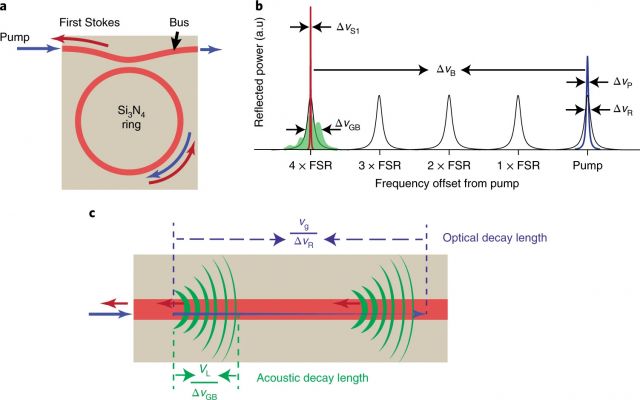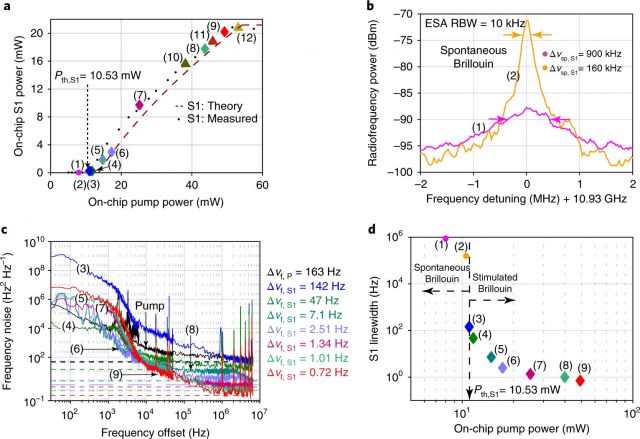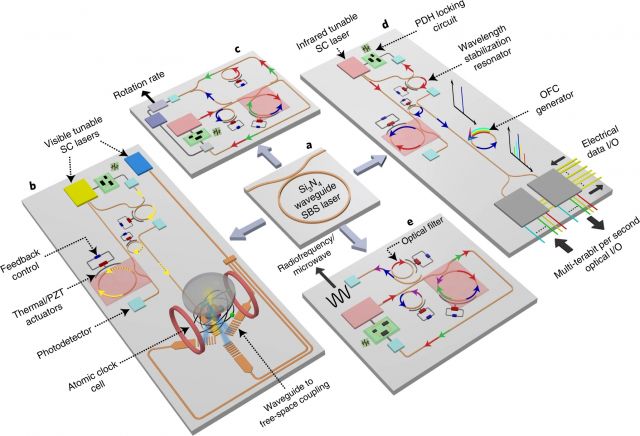Sub-Hertz Fundamental Linewidth Infra-red SBS Lasers
This is work is published on Nature Photonics: Gundavarapu, Sarat, et al. "Sub-hertz fundamental linewidth photonic integrated Brillouin laser." Nature Photonics 13.1 (2019): 60-67.
We accomplish narrow-linewidth lasers using the optical technique called stimulated Brillouin scattering (SBS). The process:
- (a) Generation of an SBS S1 line in a Si3N4 waveguide Brillouin laser. Pump light injected into the resonator builds to high intensities, leading to spontaneous Brillouin scattering that populates S1. The circulating pump amplifies this incoherent Stokes light, initiating laser oscillation when the round-trip gain compensates for the resonator losses. Brillouin interactions couple counter-propagating optical fields (for example, pump and S1) through travelling sound waves that provide gain for optical amplification. Further increase in the pump power produces successive cascaded-order lasing where distinct wavelengths at the cavity resonances are emitted.
- (b) Laser resonator modes, broadened Brillouin gain spectra (ΔνGB), and input pump and generated S1 spectra are illustrated in black, green, blue and red, respectively. The Brillouin gain peak is offset from the pump by ΔνB = νP – νS1 ~ 11 GHz, where νP is the pump frequency and νS1 is the frequency of S1.
- (c) Illustration of phonon generation in an ultralow-loss, high-Q optical resonator without acoustic guiding, where the long optical photon lifetime facilitates continuous generation of short-lived phonons. The large gain spectral width ΔνGB is determined by the fast phonon decay rate. The weak Stokes beam is amplified as it propagates along the waveguide by energy transfer from the pump beam via the phonons. Bulk-like phonons, illustrated as the green diffracting semi-circular waves, have a phonon decay rate three to four times faster than other chip-scale Brillouin lasers and are advantageous for realizing a narrow-linewidth laser.
Notes: The quantities ΔνR, ΔνP and ΔνS1 denote the resonator, pump and S1 linewidths, respectively. The quantities vg and VL denote the optical group velocity and longitudinal acoustic velocity, respectively.

We can quantify the linewidth of our narrow-linewidth SBS lasers.
- (c) Measurement of the S1 single-sided frequency noise as a function of pump power starting at threshold and above threshold (points (3)–(9)). The dotted lines indicate the far-from-carrier white-frequency-noise level determined by the emission fundamental linewidth. The pump laser frequency noise and its fundamental linewidth are shown in black demonstrating significant pump diffusion phase noise reduction and linewidth narrowing.
- (d) Linewidth evolution of S1 from ~1 MHz spontaneous linewidth below threshold to ~0.7 Hz fundamental linewidth above threshold at the onset of S2 lasing. These results demonstrate spontaneous emission bandwidth reduction up to the threshold and the onset of dramatic linewidth reduction at the threshold with continued linewidth narrowing as the pump power is increased.

Applications
On-chip narrow-linewidth laser sources is our driving technology for a number of exciting applications. These include:
- Chip-scale atomic clocks - an atomic cell probed by a visible Si3N4 waveguide Brillouin laser (b)
- Integrated laser optical gyroscopes - to detect rotation rate based on the Sagnac-induced phase shift between counter-propagating Stokes orders (c)
- WDM multi-terabit per second coherent transceivers using a Si3N4 waveguide Brillouin laser-pumped Si3N4 Kerr optical frequency comb (OFC) generator and a multi-channel integrated coherent silicon photonics transceiver (d)
- Low-noise, chip-scale photonic microwave synthesizers that generate microwave frequencies by photo-mixing the highly coherent optical Stokes frequencies emitted from a cascaded-order Si3N4 waveguide Brillouin laser (e)
Notes: I/O, input/output; PDH, Pound–Drever–Hall; PZT, piezoelectric transducer. (a) Si3N4 waveguide stimulated Brillouin scattering (SBS) laser.
